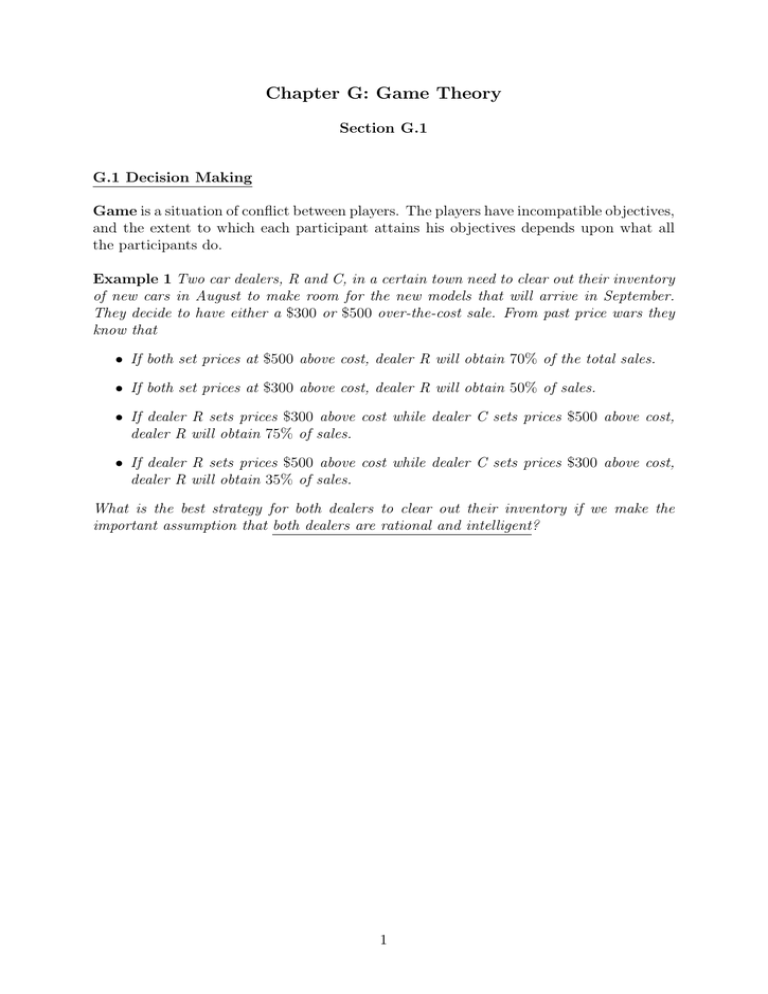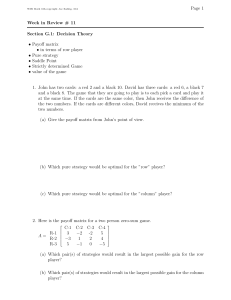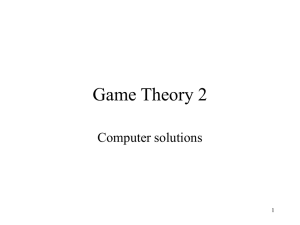Chapter G: Game Theory
advertisement

Chapter G: Game Theory Section G.1 G.1 Decision Making Game is a situation of conflict between players. The players have incompatible objectives, and the extent to which each participant attains his objectives depends upon what all the participants do. Example 1 Two car dealers, R and C, in a certain town need to clear out their inventory of new cars in August to make room for the new models that will arrive in September. They decide to have either a $300 or $500 over-the-cost sale. From past price wars they know that • If both set prices at $500 above cost, dealer R will obtain 70% of the total sales. • If both set prices at $300 above cost, dealer R will obtain 50% of sales. • If dealer R sets prices $300 above cost while dealer C sets prices $500 above cost, dealer R will obtain 75% of sales. • If dealer R sets prices $500 above cost while dealer C sets prices $300 above cost, dealer R will obtain 35% of sales. What is the best strategy for both dealers to clear out their inventory if we make the important assumption that both dealers are rational and intelligent? 1 The above game is an example of a game. A game is called two-person constant-sum game if the following are satisfied: 1. There are two players (called the row player and the column paper). 2. The row player must choose one of the m row strategies and simultaneously, the column player must choose one of n column strategies. 3. At any instant the sum of the winnings of the row and column player is always a fixed constant, given by c(say). 4. If the row player chooses her i th strategy and the column player chooses his j th strategy, the row player receives aij and the column player receives c − aij . The general situation is this Column’s Strategy Row’s strategy a11 a21 . .. am1 a12 ··· a22 ··· .. . ··· am2 ··· a1n a2n .. . amn The m × n matrix A = (aij ) containing the payoffs when the row player chooses the strategy in row i and the column player chooses the strategy in column j is called the . Note: The payoff matrix is constructed from the point of view of the row player. When the constant sum of a two player game is zero, it is called a . Note: 1. In a zero sum game, the payoff for the column player is just the negative of the payoff for the row player. 2. The loss for the column player is the gain for the row player. 2 Example 2 Consider a game with the following payoff matrix. −3 −1 0 −2 0 2 −4 0 −1 where the element in the ith row and the j th column represents the amount in dollars that the row player wins from the column player. (A negative win means the row player loses this amount.) Find the best strategies for each player. The optimum value that the row player wins from the game is called the . If the payoff value is zero, the game is called 3 . Consider superimposing the two matrices from the previous example. Consider the payoff matrix A. If there is an entry, ahk , that is the minimum in its row (row h) and also the maximum in its column (column k), we call the entry ahk , . a . A game with a saddle point is said to be If a game has a saddle point, ahk then the number ahk is called the of the game. In a game with a saddle point, the optimal strategy for the row player is to choose row Rh (the row containing a saddle) and the optimal strategy for the column player is to choose column Ck (the column containing a saddle). Locating a Saddle Point (m & M method) 1. For each row, find the minimum value and place a small “m” next to it. 2. For each column, find the maximum value and place a capital “M” next to it. 3. Any entry with both a small “m” and a capital “M” next to it is a saddle point. A saddle point can also be thought of as an equilibrium point. 4 Example 3 Determine if the game with the following payoff matrix is strictly determined. If it is, find the value of the game and the optimal strategies of each of the players. Is it a fair game? −3 0 −2 1 2 0 3 1 −1 Can a game have more than one saddle point? 5 Example 4 Determine the value of the game with the following payoff matrix. Is it a fair game? 0 1 1 0 1 1 2 1 1 2 3 1 Do all games have strictly determined strategies? 6 Example 5 Two players, called Odd and Even, simultaneously put out either 1 or 2 fingers. If the sum of all the fingers from both players is odd, then Odd wins $1 from Even. If the sum of all the fingers from both players is even, then Odd loses $1 to Even. Let Odd be the row player and Even the column player. Find the payoff matrix and determine if there is a saddle point. Even Odd 7







